diff options
Diffstat (limited to 'docs/guides/monitor/kubernetes-k8s-netdata.md')
| -rw-r--r-- | docs/guides/monitor/kubernetes-k8s-netdata.md | 278 |
1 files changed, 278 insertions, 0 deletions
diff --git a/docs/guides/monitor/kubernetes-k8s-netdata.md b/docs/guides/monitor/kubernetes-k8s-netdata.md new file mode 100644 index 000000000..40af0e94e --- /dev/null +++ b/docs/guides/monitor/kubernetes-k8s-netdata.md @@ -0,0 +1,278 @@ +<!-- +title: "Monitor a Kubernetes (k8s) cluster with Netdata" +description: "Use Netdata's helmchart, service discovery plugin, and Kubelet/kube-proxy collectors for real-time visibility into your Kubernetes cluster." +image: /img/seo/guides/monitor/kubernetes-k8s-netdata.png +custom_edit_url: https://github.com/netdata/netdata/edit/master/docs/guides/monitor/kubernetes-k8s-netdata.md +--> + +# Monitor a Kubernetes cluster with Netdata + +While Kubernetes (k8s) might simplify the way you deploy, scale, and load-balance your applications, not all clusters +come with "batteries included" when it comes to monitoring. Doubly so for a monitoring stack that helps you actively +troubleshoot issues with your cluster. + +Some k8s providers, like GKE (Google Kubernetes Engine), do deploy clusters bundled with monitoring capabilities, such +as Google Stackdriver Monitoring. However, these pre-configured solutions might not offer the depth of metrics, +customization, or integration with your preferred alerting methods. + +Without this visibility, it's like you built an entire house and _then_ smashed your way through the finished walls to +add windows. + +At Netdata, we're working to build Kubernetes monitoring tools that add visibility without complexity while also helping +you actively troubleshoot anomalies or outages. Better yet, this toolkit includes a few complementary collectors that +let you monitor the many layers of a Kubernetes cluster entirely for free. + +We already have a few complementary tools and collectors for monitoring the many layers of a Kubernetes cluster, +_entirely for free_. These methods work together to help you troubleshoot performance or availability issues across +your k8s infrastructure. + +- A [Helm chart](https://github.com/netdata/helmchart), which bootstraps a Netdata Agent pod on every node in your + cluster, plus an additional parent pod for storing metrics and managing alarm notifications. +- A [service discovery plugin](https://github.com/netdata/agent-service-discovery), which discovers and creates + configuration files for [compatible + applications](https://github.com/netdata/helmchart#service-discovery-and-supported-services) and any endpoints + covered by our [generic Prometheus + collector](https://learn.netdata.cloud/docs/agent/collectors/go.d.plugin/modules/prometheus). With these + configuration files, Netdata collects metrics from any compatible applications as they run _inside_ of a pod. + Service discovery happens without manual intervention as pods are created, destroyed, or moved between nodes. +- A [Kubelet collector](https://learn.netdata.cloud/docs/agent/collectors/go.d.plugin/modules/k8s_kubelet), which runs + on each node in a k8s cluster to monitor the number of pods/containers, the volume of operations on each container, + and more. +- A [kube-proxy collector](https://learn.netdata.cloud/docs/agent/collectors/go.d.plugin/modules/k8s_kubeproxy), which + also runs on each node and monitors latency and the volume of HTTP requests to the proxy. +- A [cgroups collector](/collectors/cgroups.plugin/README.md), which collects CPU, memory, and bandwidth metrics for + each container running on your k8s cluster. + +By following this guide, you'll learn how to discover, explore, and take away insights from each of these layers in your +Kubernetes cluster. Let's get started. + +## Prerequisites + +To follow this guide, you need: + +- A working cluster running Kubernetes v1.9 or newer. +- The [kubectl](https://kubernetes.io/docs/reference/kubectl/overview/) command line tool, within [one minor version + difference](https://kubernetes.io/docs/tasks/tools/install-kubectl/#before-you-begin) of your cluster, on an + administrative system. +- The [Helm package manager](https://helm.sh/) v3.0.0 or newer on the same administrative system. + +**You need to install the Netdata Helm chart on your cluster** before you proceed. See our [Kubernetes installation +process](/packaging/installer/methods/kubernetes.md) for details. + +This guide uses a 3-node cluster, running on Digital Ocean, as an example. This cluster runs CockroachDB, Redis, and +Apache, which we'll use as examples of how to monitor a Kubernetes cluster with Netdata. + +```bash +kubectl get nodes +NAME STATUS ROLES AGE VERSION +pool-0z7557lfb-3fnbf Ready <none> 51m v1.17.5 +pool-0z7557lfb-3fnbx Ready <none> 51m v1.17.5 +pool-0z7557lfb-3fnby Ready <none> 51m v1.17.5 + +kubectl get pods +NAME READY STATUS RESTARTS AGE +cockroachdb-0 1/1 Running 0 44h +cockroachdb-1 1/1 Running 0 44h +cockroachdb-2 1/1 Running 1 44h +cockroachdb-init-q7mp6 0/1 Completed 0 44h +httpd-6f6cb96d77-4zlc9 1/1 Running 0 2m47s +httpd-6f6cb96d77-d9gs6 1/1 Running 0 2m47s +httpd-6f6cb96d77-xtpwn 1/1 Running 0 11m +netdata-child-5p2m9 2/2 Running 0 42h +netdata-child-92qvf 2/2 Running 0 42h +netdata-child-djc6w 2/2 Running 0 42h +netdata-parent-0 1/1 Running 0 42h +redis-6bb94d4689-6nn6v 1/1 Running 0 73s +redis-6bb94d4689-c2fk2 1/1 Running 0 73s +redis-6bb94d4689-tjcz5 1/1 Running 0 88s +``` + +## Explore Netdata's Kubernetes charts + +The Helm chart installs and enables everything you need for visibility into your k8s cluster, including the service +discovery plugin, Kubelet collector, kube-proxy collector, and cgroups collector. + +To get started, open your browser and navigate to your cluster's Netdata dashboard. See our [Kubernetes installation +instructions](/packaging/installer/methods/kubernetes.md) for how to access the dashboard based on your cluster's +configuration. + +You'll see metrics from the parent pod as soon as you navigate to the dashboard: + +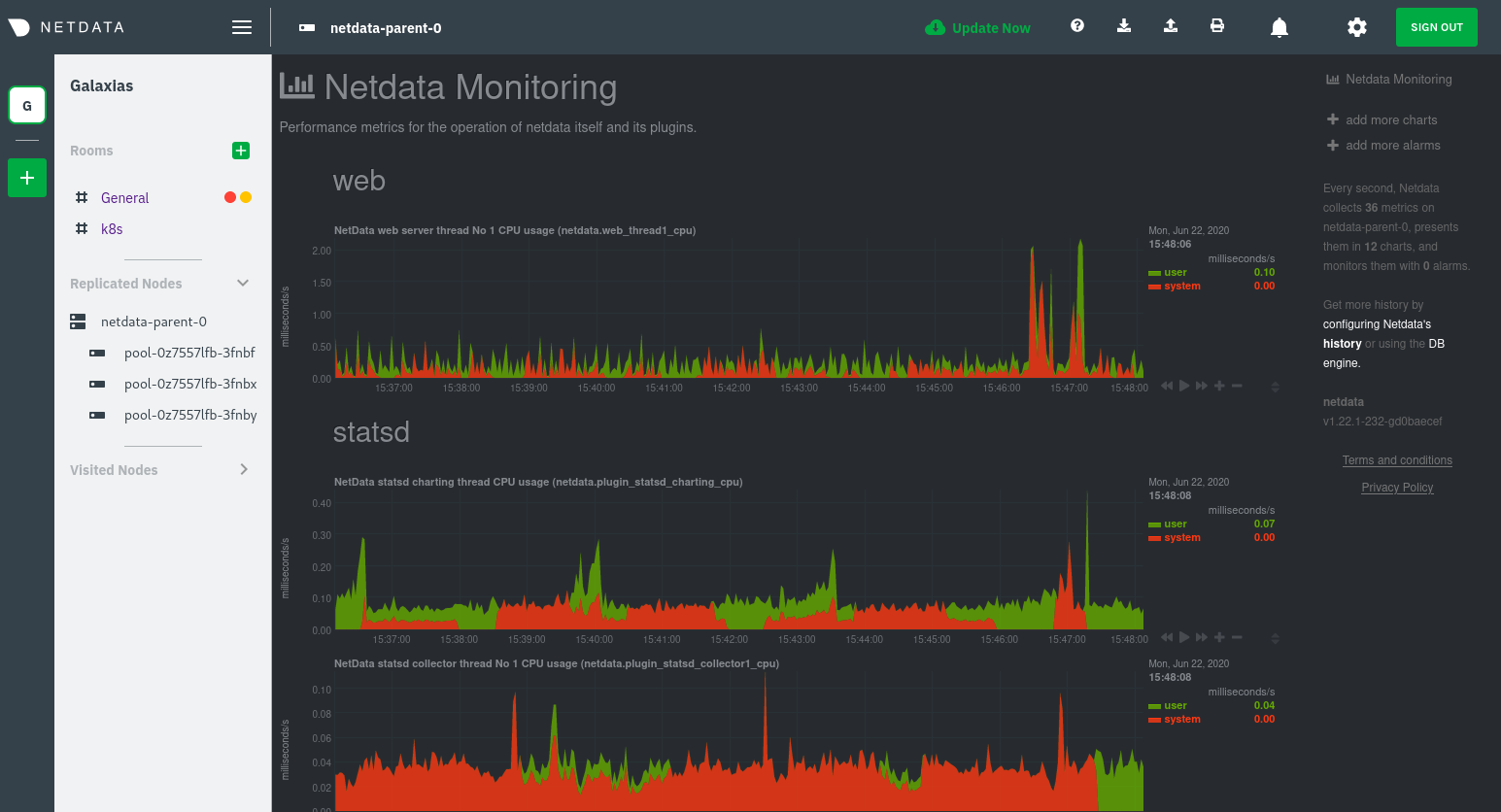 + +Remember that the parent pod is responsible for storing metrics from all the child pods and sending alarms. + +Take note of the **Replicated Nodes** menu, which shows not only the parent pod, but also the three child pods. This +example cluster has three child pods, but the number of child pods depends entirely on the number of nodes in your +cluster. + +You'll use the links in the **Replicated Nodes** menu to navigate between the various pods in your cluster. Let's do +that now to explore the pod-level Kubernetes monitoring Netdata delivers. + +### Pods + +Click on any of the nodes under **netdata-parent-0**. Netdata redirects you to a separate instance of the Netdata +dashboard, run by the Netdata child pod, which visualizes thousands of metrics from that node. + +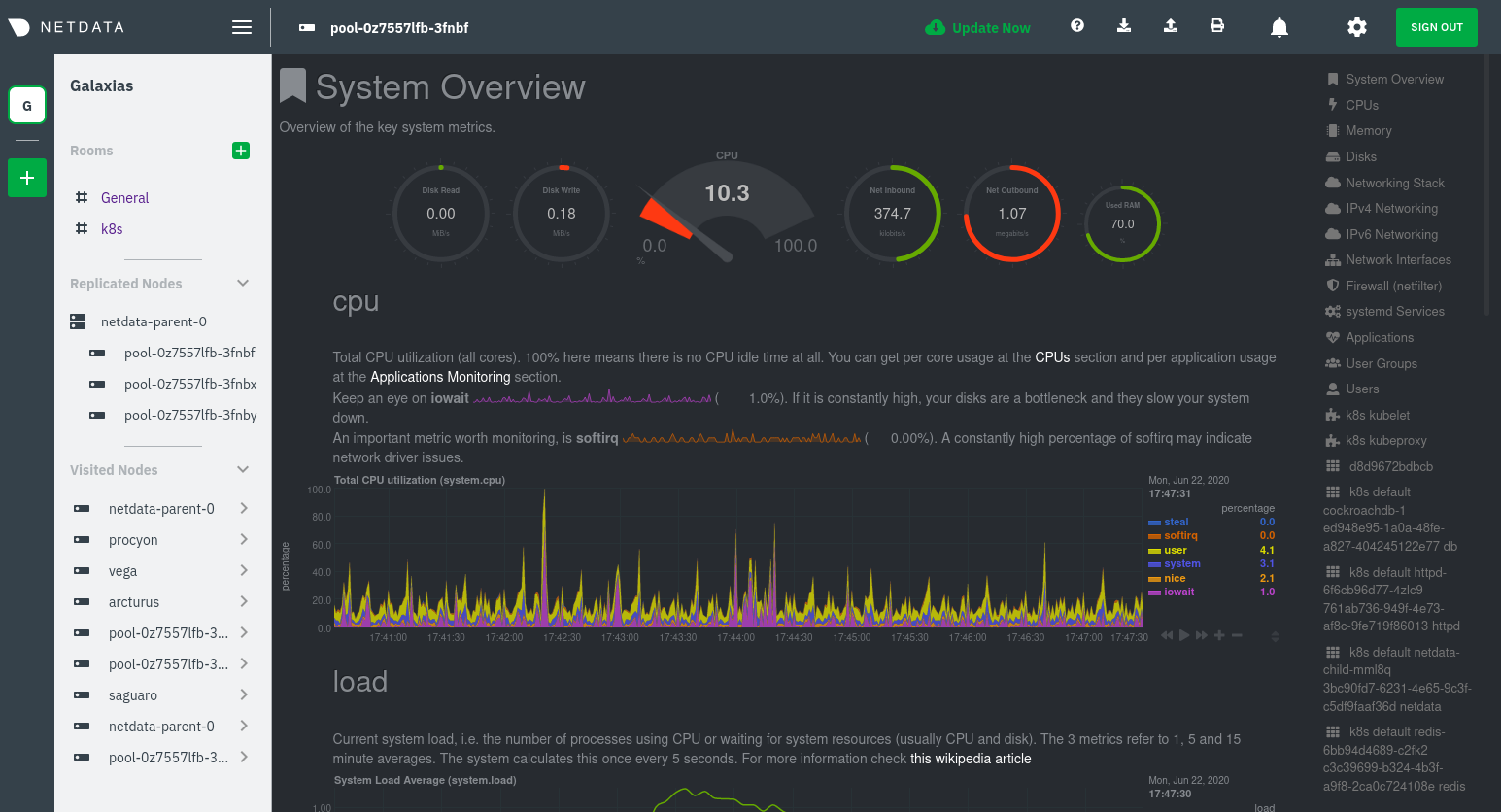 + +From this dashboard, you can see all the familiar charts showing the health and performance of an individual node, just +like you would if you installed Netdata on a single physical system. Explore CPU, memory, bandwidth, networking, and +more. + +You can use the menus on the right-hand side of the dashboard to navigate between different sections of charts and +metrics. + +For example, click on the **Applications** section to view per-application metrics, collected by +[apps.plugin](/collectors/apps.plugin/README.md). The first chart you see is **Apps CPU Time (100% = 1 core) +(apps.cpu)**, which shows the CPU utilization of various applications running on the node. You shouldn't be surprised to +find Netdata processes (`netdata`, `sd-agent`, and more) alongside Kubernetes processes (`kubelet`, `kube-proxy`, and +`containers`). + +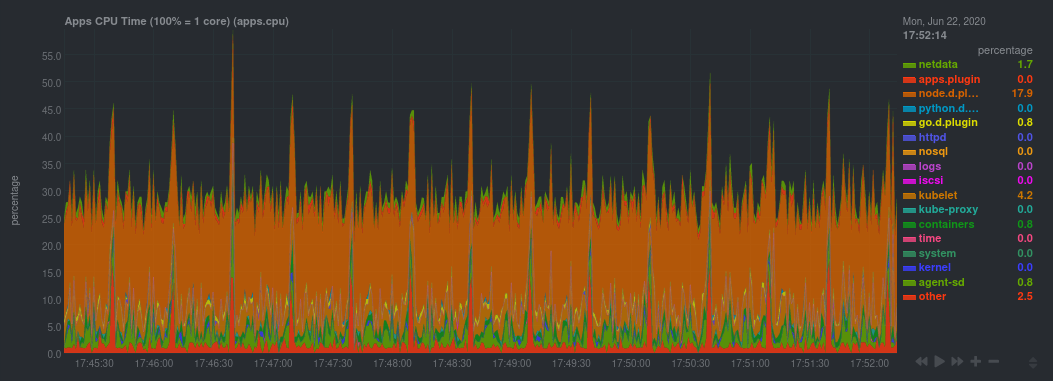 + +Beneath the **Applications** section, you'll begin to see sections for **k8s kubelet**, **k8s kubeproxy**, and long +strings that start with **k8s**, which are sections for metrics collected by +[`cgroups.plugin`](/collectors/cgroups.plugin/README.md). Let's skip over those for now and head further down to see +Netdata's service discovery in action. + +### Service discovery (services running inside of pods) + +Thanks to Netdata's service discovery feature, you monitor containerized applications running in k8s pods with zero +configuration or manual intervention. Service discovery is like a watchdog for created or deleted pods, recognizing the +service they run based on the image name and port and immediately attempting to apply a logical default configuration. + +Service configuration supports [popular +applications](https://github.com/netdata/helmchart#service-discovery-and-supported-services), plus any endpoints covered +by our [generic Prometheus collector](https://learn.netdata.cloud/docs/agent/collectors/go.d.plugin/modules/prometheus), +which are automatically added or removed from Netdata as soon as the pods are created or destroyed. + +You can find these service discovery sections near the bottom of the menu. The names for these sections follow a +pattern: the name of the detected service, followed by a string of the module name, pod TUID, service type, port +protocol, and port number. See the graphic below to help you identify service discovery sections. + +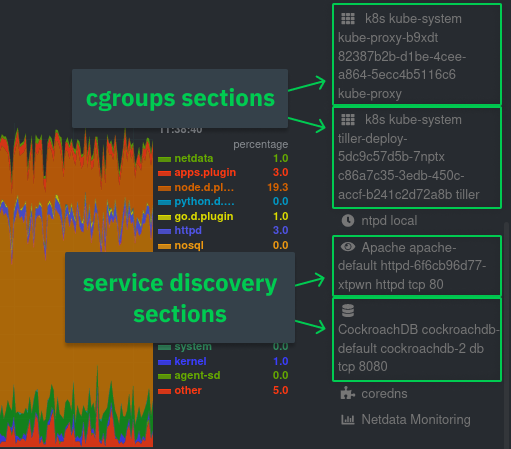 + +For example, the first service discovery section shows metrics for a pod running an Apache web server running on port 80 +in a pod named `httpd-6f6cb96d77-xtpwn`. + +> If you don't see any service discovery sections, it's either because your services are not compatible with service +> discovery or you changed their default configuration, such as the listening port. See the [list of supported +> services](https://github.com/netdata/helmchart#service-discovery-and-supported-services) for details about whether +> your installed services are compatible with service discovery, or read the [configuration +> instructions](/packaging/installer/methods/kubernetes.md#configure-service-discovery) to change how it discovers the +> supported services. + +Click on any of these service discovery sections to see metrics from that particular service. For example, click on the +**Apache apache-default httpd-6f6cb96d77-xtpwn httpd tcp 80** section brings you to a series of charts populated by the +[Apache collector](https://learn.netdata.cloud/docs/agent/collectors/go.d.plugin/modules/apache) itself. + +With service discovery, you can now see valuable metrics like requests, bandwidth, workers, and more for this pod. + +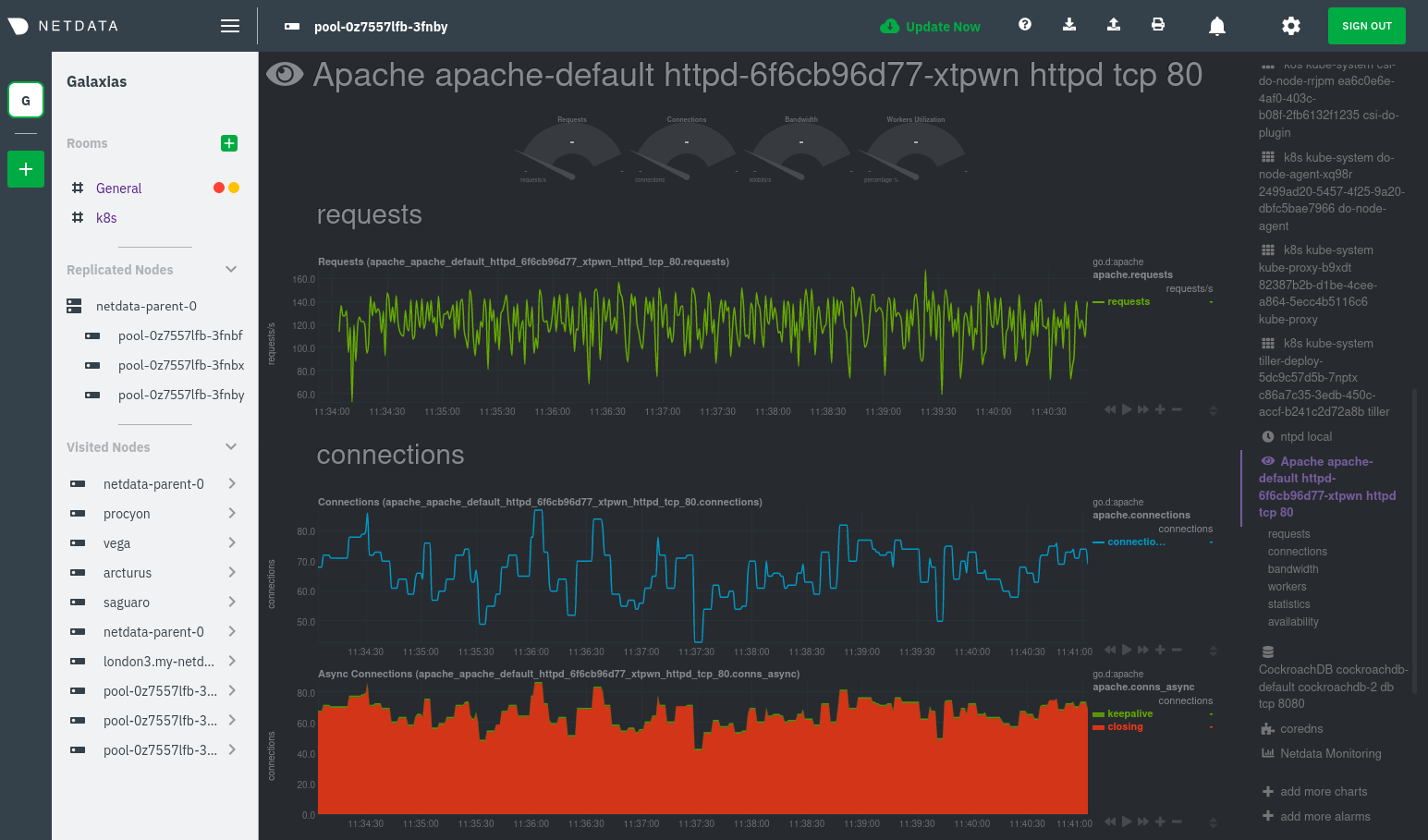 + +The same goes for metrics coming from the CockroachDB pod running on this same node. + +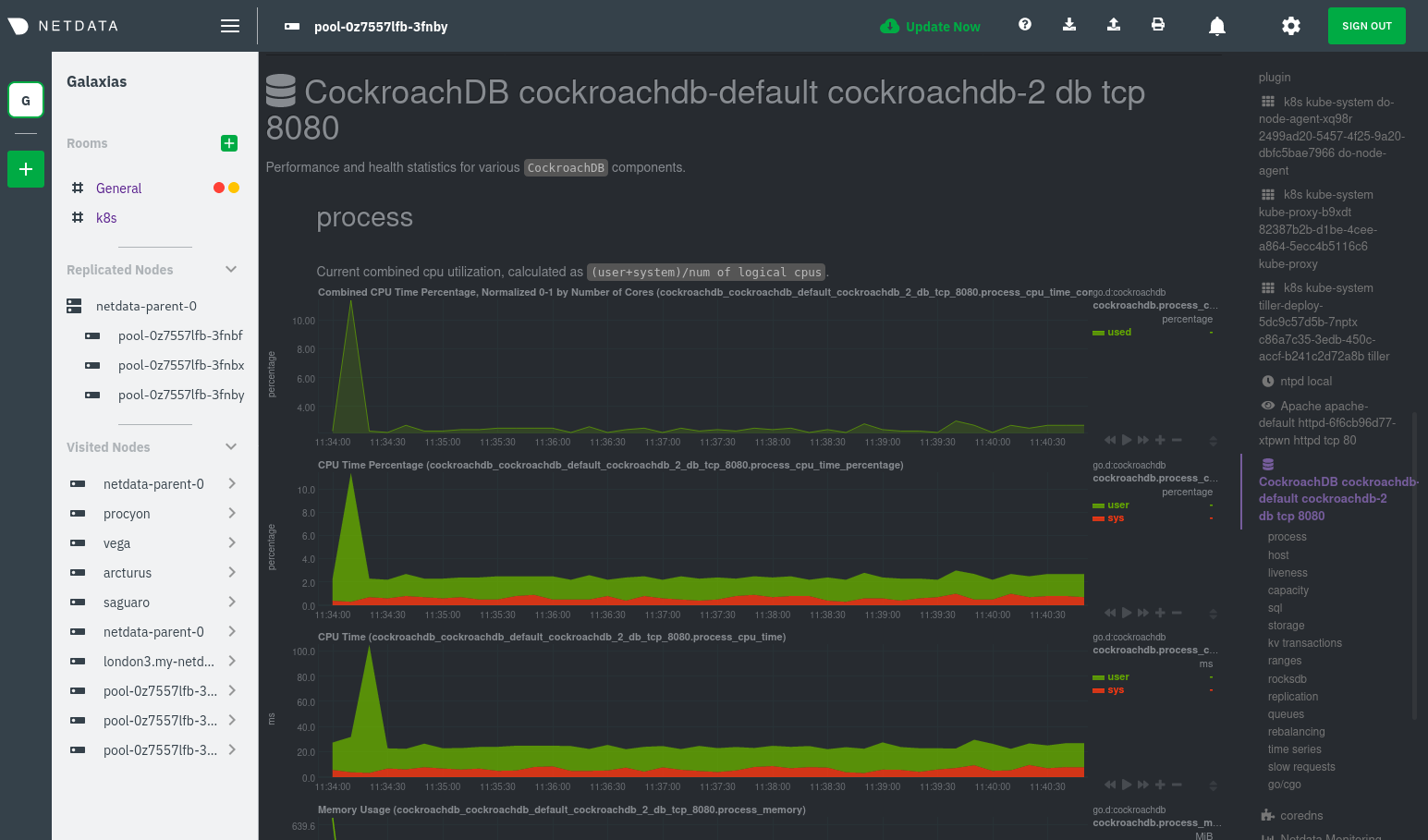 + +Service discovery helps you monitor the health of specific applications running on your Kubernetes cluster, which in +turn gives you a complete resource when troubleshooting your infrastructure's health and performance. + +### Kubelet + +Let's head back up the menu to the **k8s kubelet** section. Kubelet is an agent that runs on every node in a cluster. It +receives a set of PodSpecs from the Kubernetes Control Plane and ensures the pods described there are both running and +healthy. Think of it as a manager for the various pods on that node. + +Monitoring each node's Kubelet can be invaluable when diagnosing issues with your Kubernetes cluster. For example, you +can see when the volume of running containers/pods has dropped. + +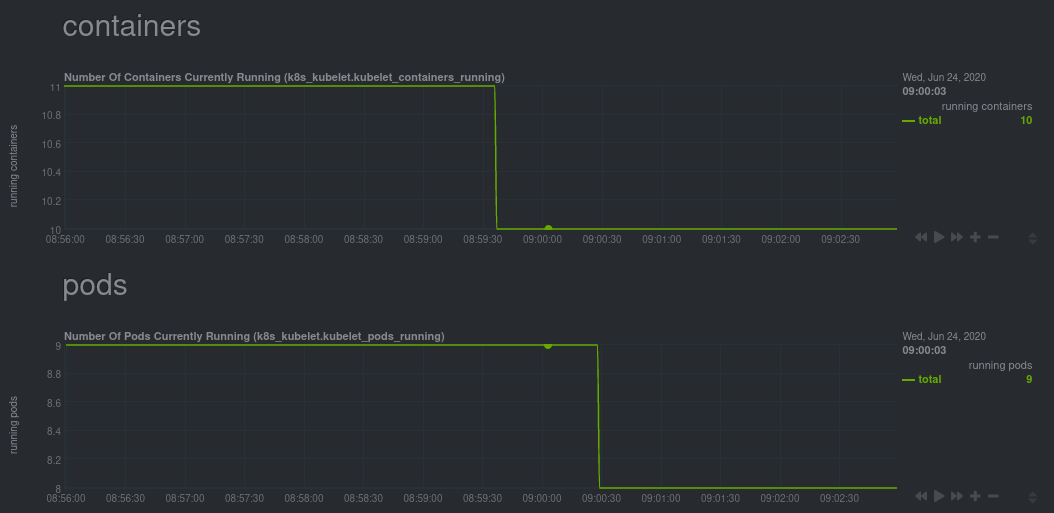 + +This drop might signal a fault or crash in a particular Kubernetes service or deployment (see `kubectl get services` or +`kubectl get deployments` for more details). If the number of pods increases, it may be because of something more +benign, like another member of your team scaling up a service with `kubectl scale`. + +You can also view charts for the Kubelet API server, the volume of runtime/Docker operations by type, +configuration-related errors, and the actual vs. desired numbers of volumes, plus a lot more. + +Kubelet metrics are collected and visualized thanks to the [kubelet +collector](https://learn.netdata.cloud/docs/agent/collectors/go.d.plugin/modules/k8s_kubelet), which is enabled with +zero configuration on most Kubernetes clusters with standard configurations. + +### kube-proxy + +Scroll down into the **k8s kubeproxy** section to see metrics about the network proxy that runs on each node in your +Kubernetes cluster. kube-proxy allows for pods to communicate with each other and accept sessions from outside your +cluster. + +With Netdata, you can monitor how often your k8s proxies are syncing proxy rules between nodes. Dramatic changes in +these figures could indicate an anomaly in your cluster that's worthy of further investigation. + +kube-proxy metrics are collected and visualized thanks to the [kube-proxy +collector](https://learn.netdata.cloud/docs/agent/collectors/go.d.plugin/modules/k8s_kubeproxy), which is enabled with +zero configuration on most Kubernetes clusters with standard configurations. + +### Containers + +We can finally talk about the final piece of Kubernetes monitoring: containers. Each Kubernetes pod is a set of one or +more cooperating containers, sharing the same namespace, all of which are resourced and tracked by the cgroups feature +of the Linux kernel. Netdata automatically detects and monitors each running container by interfacing with the cgroups +feature itself. + +You can find these sections beneath **Users**, **k8s kubelet**, and **k8s kubeproxy**. Below, a number of containers +devoted to running services like CockroachDB, Apache, Redis, and more. + +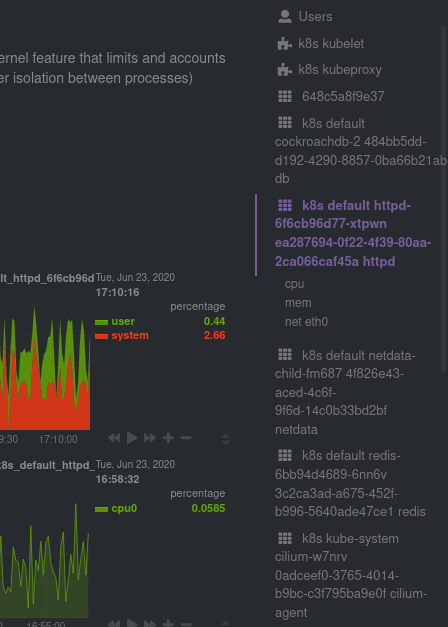 + +Let's look at the section devoted to the container that runs the Apache pod named `httpd-6f6cb96d77-xtpwn`, as described +in the previous part on [service discovery](#service-discovery-services-running-inside-of-pods). + +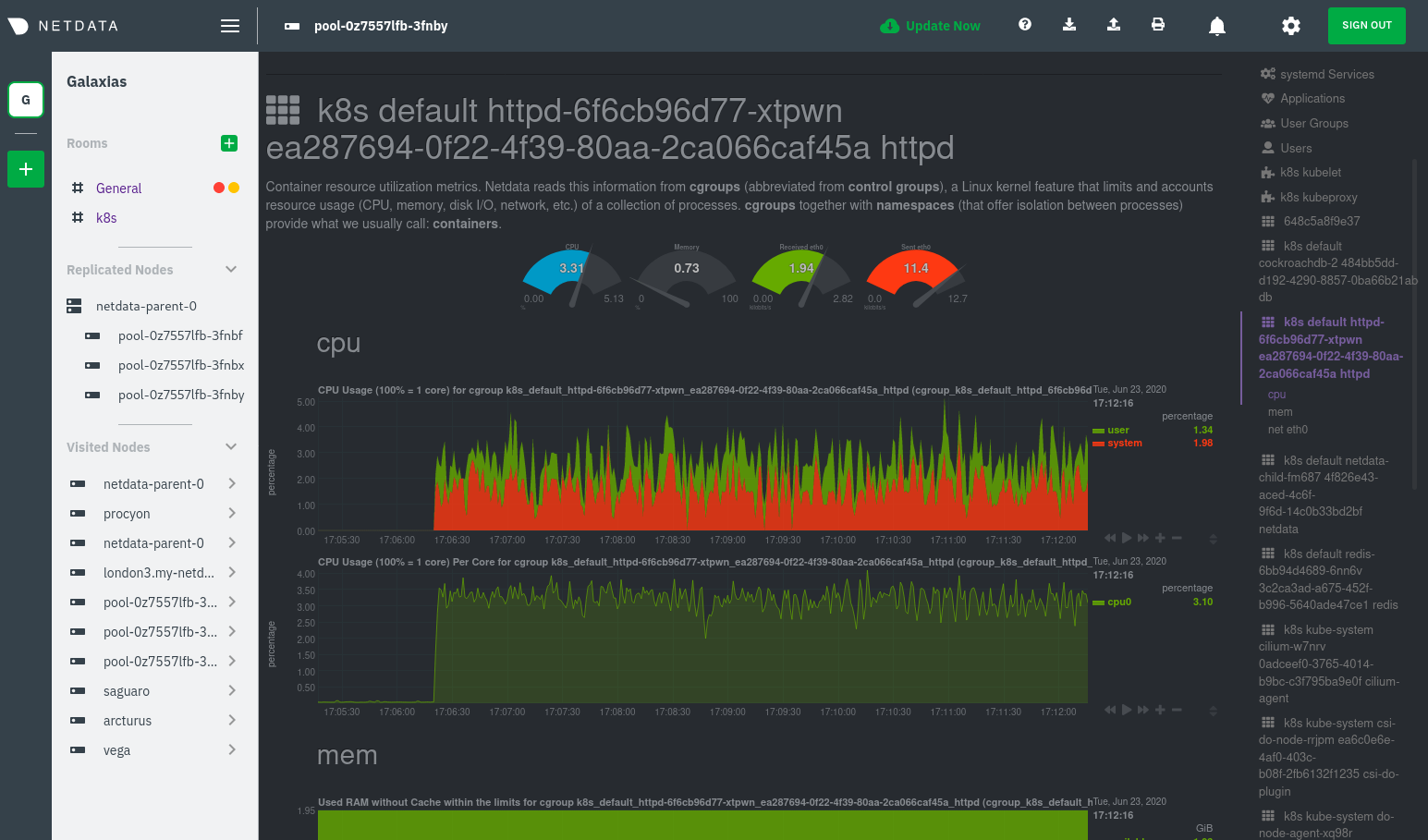 + +At first glance, these sections might seem redundant. You might ask, "Why do I need both a service discovery section +_and_ a container section? It's just one pod, after all!" + +The difference is that while the service discovery section shows _Apache_ metrics, the equivalent cgroups section shows +that container's CPU, memory, and bandwidth usage. You can use the two sections in conjunction to monitor the health and +performance of your pods and the services they run. + +For example, let's say you get an alarm notification from `netdata-parent-0` saying the +`ea287694-0f22-4f39-80aa-2ca066caf45a` container (also known as the `httpd-6f6cb96d77-xtpwn` pod) is using 99% of its +available RAM. You can then hop over to the **Apache apache-default httpd-6f6cb96d77-xtpwn httpd tcp 80** section to +further investigate why Apache is using an unexpected amount of RAM. + +All container metrics, whether they're managed by Kubernetes or the Docker service directly, are collected by the +[cgroups collector](/collectors/cgroups.plugin/README.md). Because this collector integrates with the cgroups Linux +kernel feature itself, monitoring containers requires zero configuration on most Kubernetes clusters. + +## What's next? + +After following this guide, you should have a more comprehensive understanding of how to monitor your Kubernetes cluster +with Netdata. With this setup, you can monitor the health and performance of all your nodes, pods, services, and k8s +agents. Pre-configured alarms will tell you when something goes awry, and this setup gives you every per-second metric +you need to make informed decisions about your cluster. + +The best part of monitoring a Kubernetes cluster with Netdata is that you don't have to worry about constantly running +complex `kubectl` commands to see hundreds of highly granular metrics from your nodes. And forget about using `kubectl +exec -it pod bash` to start up a shell on a pod to find and diagnose an issue with any given pod on your cluster. + +And with service discovery, all your compatible pods will automatically appear and disappear as they scale up, move, or +scale down across your cluster. + +To monitor your Kubernetes cluster with Netdata, start by [installing the Helm +chart](/packaging/installer/methods/kubernetes.md) if you haven't already. The Netdata Agent is open source and entirely +free for every cluster and every organization, whether you have 10 or 10,000 pods. A few minutes and one `helm install` +later and you'll have started on the path of building an effective platform for troubleshooting the next performance or +availability issue on your Kubernetes cluster. + +[](<>) |
